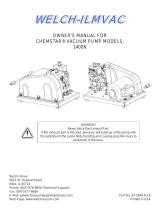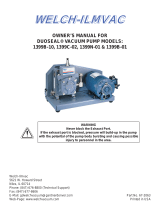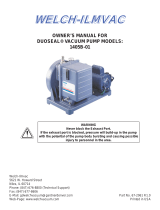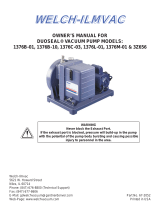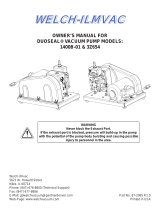Page is loading ...

OWNER’S MANUAL
FOR
WOB•L
®
PISTON
PRESSURE/VACUUM PUMPS
MODELS 2522, 2534 AND 2545
Contents: Safety Information
Installation
Operation
Maintenance
Trouble-Shooting Guide
Specifications
Warranty
Parts List and Exploded View
Warning! Not recommended for pumping acid, base or organic
vapors or gases.
Warning! Be sure to properly identify intake and discharge before
using pump.
SEE Section II-5
Welch Rietschle Thomas
7301 North Central Avenue
Skokie, IL 60077
Phone: (847) 676-8800
Fax: (847) 677-8606
CE
Part No. 67-0767 Printed in the U.S.A.
Revision A 6/99

Welch Vacuum Technology
Read and understand the following information and
instructions included with your Welch Dry Dual Function
Pressure &Vacuum Pumps before using. This information is
for your safety and to prevent damage to the pumps.
I. SAFETY INFORMATION
I-1. CAUTION TO PREVENT INJURY...
I-1a. Never operate this product if it has a damaged cord or
plug. If it is not working properly has been dropped
damaged or has fallen into water, please return the
product to a Welch service center for examination and
repair.
I-1b. Keep the cord away from heated surfaces.
I-1c. Never block any air openings or place it on a soft surface
where the openings may be blocked. The air openings
are for ventilation of the motor inside the housing. Keep
all air openings free of lint, dirt, and other foreign objects.
I-1d. Never drop or insert fingers or any other object into any
openings.
I-1e. Do not operate this product where oxygen is being
administered.
I-1f. This pump is thermally protected and can automatically
restart when the protector resets. Always disconnect
power source before servicing.
I-1g. Wear safety glasses or goggles when operating this
product.
I-1h. Use only in well ventilated areas.
I-1i. Do not use any tools or attachments without first
determining maximum air pressure for that tool or
attachment.
I-1j. Never point any air nozzle or air sprayer toward another
person or any part of the body.
I-1k. All electrical products generate heat. To avoid serious
burns never touch unit during or immediately after
operation.
I-1l. Be sure to properly identify intake and discharge before
using pump. See Section II-5.
I-2. CAUTION: TO REDUCE RISK OF
ELECTRICAL SHOCK…
l-2a. Do not disassemble. Disassembly or attempted repairs
if accomplished incorrectly can create electrical shock
hazard. Refer servicing to qualified service agencies
only.
l-2b. Unit is supplied with a three pronged plug Be sure to
connect pump to a properly grounded outlet only.
I-3. WARNING: TO REDUCE RISK OF
ELECTROCUTION…
I-3a. Do not use this product in or near area where it can fall
or be pulled into water or other liquids.
I-3b. Do not reach for this product if it has fallen into liquid.
Unplug immediately.
I-3c. Never operate this product outdoors in the rain or in a
wet area.
I-4. DANGER: TO REDUCE RISK
OF EXPLOSION OR FIRE…
I-4a. Do not use this pump in or near explosive atmospheres
or where aerosol (spray) products are being used.
I-4b. Do not pump anything other than atmospheric air.
1-4c. Do not pump combustible liquids or vapors with this
product or use in or near an area where flammable or
explosive liquids or vapors may exist.
I-4d. Do not use this product near flames.
FAILURE TO OBSERVE THE ABOVE
SAFETY PRECAUTIONS COULD RESULT
IN SEVERE BODILY INJURY, INCLUDING
DEATH IN EXTREME CASES.
II. INSTALLATION
Il-1. INTRODUCTION
This manual has been compiled not only for the care and
maintenance of the Welch Dry Dual Function Pressure/Vacuum
pump now in your possession, but as a helpful reference and guide
to prevent many problems which can occur if used improperly.
II-2. UNPACKING
Carefully remove the Pressure/Vacuum pump from the shipping
case and unfasten and remove the wooden skid. Preserve all
paperwork for future reference. If damage has occurred from
shipment a claim must be filed with the carrier immediately;
preserve the shipping carton for inspection by the carrier. If you
are required to communicate with your dealer or Welch Vacuum,
be sure to include your order numbers for quick identification.
Do not return the pump to the factory without first calling for a
returned goods number.
Il-3. PUMP MOUNTING
Rubber feet are attached to the pump. Rubber feet are excellent
for applications involving a semi-flexible surface such as a bench
top; they help to isolate noise and eliminate creeping. All Pressure/
Vacuum pumps should he mounted on a horizontal plane.
II-4. PUMP LOCATION
The pressure/vacuum pump should be located preferably in a
clean, dry, and well ventilated area. Please be sure not to block
the ventilation holes located on the motor housing. The pump
should be placed where the surrounding temperature remains
between 10°C and 40°C (50°F and 104°F). Always check to insure
the location chosen is protected from direct or indirect moisture
contact. Welch recommends that the pump be installed at the
highest point within the system to prevent possible water
condensate from entering the pump. The pump should be located
as closely to its system in order to utilize it most efficiently.
Warning! The motor is thermally protected and
will automatically restart unexpectedly when
the overload device resets. Don’t pump
flammable or explosive gases or vapors or
operate this pump in an atmosphere containing
flammable or explosive gases or vapors.
II-5. INTAKE AND DISCHARGE PROVISIONS
Two regulators and two gauges make it easy to meet your vacuum
and pressure requirements. The vacuum regulator and vacuum
dial gauge is attached to the intake port. The vacuum regulator
allows the vacuum level to be set between roughly atmospheric
pressure and the maximum vacuum allowed for the pump model.
A moisture trap keeps water from accidentally being drawn into
the unit.

The pressure regulator and pressure dial gauges are attached to the
discharge port. The pressure regulator allows discharge pressure to
be set between atmospheric and the maximum possible for the pump
model. Discharge air is filtered and noise is muffled with a filter.
Note: Adjusting either the pressure or vacuum regulators will
affect the performance of the pump.
PROPERLY IDENTIFY THE INTAKE AND
DISCHARGE OF THE PUMP
WARNING!: Never Block The Discharge Port.
If the exhaust is blocked, pressure will build- up
in the pump above its rated operating pressure.
Be sure to call Welch technical service prior to start-up at (847)
676-8800 if you have any questions.
II-6. ELECTRICAL POWER
lI-6a. Power Source Review
Review the power source and the motor rating to be sure they agree
in voltage, phase, and frequency. Serious damage may occur to the
motor if it is connected to an improper voltage. All Welch pumps
must be grounded. Grounding reduces the risk of electric shock in
the event of an electrical short circuit. The plug must be plugged
into a properly grounded outlet. Consult your local electrical codes
if you have doubts.
ll-6b. Overload Protection.
Motor thermal overload protection is made available by the motor
manufacturer as an aid to minimize motor failure.
Overload protection is a standard feature on both 50 and 60 Hz
single-phase-motors. The motors have automatic overload
protection. Automatic reset protection is designed to reset itself
after a predetermined cooling period. If the fault to the drive remains
unaltered, the motor will cycle on and off until the fault is corrected.
II-7. VACUUM CONNECTIONS
All pressure/vacuum pumps come with intake and discharge hose
barbs which accept 1/4" ID rubber pressure/vacuum hose. Hose
clamps should be used to hold the hose in place. Since all three
models operate in the viscous flow regime, the small diameter of
the hose will generate minimal conductance loss. For best results,
Welch recommends the length of the tubing between the pump and
the chamber be kept as small as possible.
II-8. VACUUM AND PRESSURE GAUGES
All models of pressure/vacuum pumps come with dial gauges
mounted on the regulator assemblies. The vacuum gauge gives
negative pressure - that is pressure below atmospheric. The reference
point for the vacuum gauge is atmospheric pressure.
The pressure gauge gives pressure above atmospheric. The
reference point for the pressure gauge is atmospheric pressure.
Please keep in mind that atmospheric pressure tends to vary from
day to day. As a result of this variability, the dial vacuum gauge
will indicate slightly different maximum vacuum readings from
day to day.
II-9. TRAPS
II-9a. The need for a Trap
The pumps will handle humid air. All wetted aluminum parts are
treated for corrosion protection from moisture. All other wetted
parts are stainless steel. A plastic trap with a ball check valve is
attached to the regulator assembly to prevent water condensate from
accidentally being ingested into the pump. If there is a chance liquid
may be drawn from the process under evacuation, Welch
recommends a liquid trap be placed between the process and the
pump. A simple liquid trap is a filtering flask. See figure below.
When a heavy load of water vapor is evolved from the vacuum
process, a cold trap is recommended to help prevent damage to the
pump mechanism. The cold trap, immersed in a suitable Dewar
flask, is installed so that the water vapors may come in contact
with the surfaces of the trap and condense. Commonly used
refrigerants are liquid nitrogen or dry ice and acetone or alcohol.
Dry ice provides sufficient cooling to freeze out most heavy water
vapor loads. A variety of cold traps are available from Welch. Please
call our customer service department for additional information at
(847) 676-8800.
WARNING!: The pump is not recommended for
pumping acid, base or organic vapors or gases.
Serious damage to the pump will shorten the
pump’s service life. In addition, pumping
flammable vapors or gases can lead to serious
safety hazard leading to fire or explosion.
lI-9b. The Care of a Trap
When using a cold trap the refrigerant should be maintained at a
high level in the flask to keep the trap at a uniformly low
temperature. If the trap is rewarmed it may allow re-evaporation of
the condensate. The refrigerant add tube on the liquid nitrogen trap
should not be obstructed as the refrigerant boil-off can pro- duce
dangerously high pressures. If the trap becomes saturated it should
be disconnected from the system, drained, and cleaned. An increase
in pressure in the vacuum system will normally indicate that the
trap has become saturated. To clean the trap, remove the trap from
the system and allow the trap to warm up and rinse off the
condensate with a suitable solvent in a fume hood. Thoroughly
clean and dry the trap before reinstalling into the system.
Ill. OPERATION
Ill-1. STARTING PROCEDURES
Pressure/Vacuum Pump
Intake Discharge
Discharge
Suction
Filtration Manifold Liquid Trap

Ill-1a. Starting A Welch Pressure/Vacuum Pump
Before attaching the pump to a system, familiarize yourself with
the function and action of the pressure/vacuum pump that you
have acquired. Review the power requirements as described in
Section l-6. Welch recommends running the pump for a few
minutes to warm it up, before use. The warm-up improves the
pumps ability to handle humid air.
III-1b. Cleanliness
Take every precaution to prevent foreign particulates from entering
the pump. Particulates will damage the pump’s performance. If
you find that particulates come off the process during evacuation,
a particulate trap in the foreline will work. A simple, inexpensive
trap may be made by placing glass wool in a glass or plastic tube.
Screens must be inserted to hold the glass wool in place.
III-2. LEAK DETECTION
The importance of eliminating all leaks in a vacuum system is
obvious. The pump must remove this added volume of leaked gas
to maintain the desired vacuum. Leaks for these pump can be
located by slightly pressuring the system and painting the suspected
area with a thick soap solution. Escaping air will produce soap
bubbles.
III-3. OPERATING PRESSURE RANGE
Pressure/Vacuum pumps are designed to be run from slightly below
atmospheric to their maximum vacuum level on the intake side.
The pumps also may be run from atmospheric to their maximum
rated pressure rating. Consult the Specification Table (See Section
VI, Specifications) for the ratings of your specific model.
III-4. SHUTDOWN PROCEDURES
After use, Welch recommends the pump be run for about 2 minutes
disconnected from the vacuum process. The air pumped through
the mechanism will purge out water vapor or droplets of water
condensate that may have formed on the inside of the pump. This
purge of the pump mechanism helps prevent corrosion.
IV. MAINTENANCE
Welch dry pressure\vacuum units are 100% oil-free. The pump
employs a non-lube piston and cylinder. No maintenance is
necessary for the bearings. All bearings are sealed and permanently
lubricated. Lubrication should not be attempted. The units are built
for continuous duty operation with the quietness and durability of
a diaphragm, but with piston performance.
V. TROUBLESHOOTING
V-1. VACUUM PROBLEMS
Leakage, contamination, and unusual outgassing are the general
causes of problems associated with poor vacuum. To operate at
maximum efficiency, a system must be thoroughly clean. It the
system is completely clean and free from leaks, and unwarranted
vacuum problems still exist, the pump should be checked. A simple
criterion for the condition of the pump is the determination of its
maximum vacuum capability. This can be accomplished by
blocking of the intake and reading the vacuum level on the gauge
(See Section II-8).
V-2. PRESSURE PROBLEMS
Leakage and contamination are the general causes of problems
associated with poor pressure. To operate at maximum efficiency
a system must be thoroughly clean. If the system is completely
clean and free from leaks, and unwarranted pressure problems still
exist, the pump/compressor should be checked by a service technician.
(See Section II-8).
V-3. TROUBLESHOOTING GUIDE
VI. SPECIFICATIONS
Note: *230V 60Hz 1Ph models have a maximum continuous pressure
of 50 PSIG (5 x 10
5
Pascal)
**50 Hz models provided with CE mark.
WARRANTY
This Welch Vacuum product is warranted to be free from defects in
material and workmanship. This liability of Welch Vacuum, Thomas
Industries, Inc. under this warranty is limited to servicing, adjusting,
repairing, or replacing any unit or component part which in the
judgment of Welch Vacuum, Thomas Industries Inc. has not been
misused, abused, or altered in any way or damaged by ingestion of
foreign material causing impaired performance or rendering it
inoperative. Foreign material includes solids, liquids other than pump
oil, corrosive gases, and recondensed water or solvent vapor. No other
warranties are expressed or implied. The method of executing this
warranty: servicing, adjusting, repairing, or replacing, shall be at the
discretion of Welch Vacuum, Thomas Industries, Inc. Vacuum pumps
that have been operated within a vacuum system, or other system, for
any period, however short, will be repaired under this warranty rather
than replaced.
The warranty is effective for one year from the date of original
purchase when:
1. The warranty card has been completed and returned.
2. The product is returned to the factory or other designated
service centers, freight prepaid.
3. The product in our judgment is defective through no action
or fault of the user
If the product has become defective through misuse, abuse, alteration,
or ingestion of foreign material, repairs will be billed regardless of
the age of the product. In this event, an estimate of the repair costs
will be submitted and authorization of these charges will be required
before the product is repaired and returned.
Poor Pumpi n g
S p eed
P oor
Pressure
Loud Unit Possible Caus e Cor r ecti ve Act i on
XXXDamaged Valves Replace fl apper valves
XXXDebris in Valves
Remove debr i s and che ck
for valve damage
XXXDamaged Gas k et s R epl ace gaskets
XXXLoose Head S crews T i ghten head s crews
X X Loos e F i ttings T i ghten fi tti ngs

DRAWING AND PARTS LIST FOR 2522
metI
rebmuN
ytitnauQ.oNtraPnoitpircseD
tiKecivreS
30-K2252
laeS
tiKteksaG
40-K2252
ecivreS
teeF-tiK
40-K0052
11 10-K2252ylbmessAdoRgnitcennoC1
22 1etoNwercSeldnaH2
34 1etoNwercSdaeH4
41 1etoNdaeHgniR-O11
51 20-K5652ylbmessAetalPevlaV1
61 1etoNrednilyCgniR-O11
72 1etoNcitsalP-raJ11
81 1etoNtnemelEretliF11
91 787836eguaGerusserP
011 1etoNllaB11
111 887836eguaGmuucaV
212 1etoNteksaG11
314 1etoNteeFnoitcuSrebbuR4
411 60-K2252ylbmessArotalugeRerusserP
511 50-K2252ylbmessArotalugeRmuucaV
Note 1: These parts are not available separately, but are supplied within kits

DRAWING AND PARTS LIST FOR 2534
metI
rebmuN
ytitnauQ.oNtraPnoitpircseD
tiKecivreS
30-K2252
laeS
tiKteksaG
40-K2252
ecivreS
teeF-tiK
40-K0052
11 10-K2252ylbmessAdoRgnitcennoC1
22 1etoNwercSeldnaH2
34 1etoNwercSdaeH4
41 1etoNdaeHgniR-O11
51 20-K5652ylbmessAetalPevlaV1
61 1etoNrednilyCgniR-O11
72 1etoNcitsalP-raJ11
81 1etoNtnemelEretliF11
91 2921-17eguaGerusserP
011 1etoNllaB11
111 297356eguaGmuucaV
212 1etoNteksaG11
314 1etoNteeFnoitcuSrebbuR4
411 60-K2252ylbmessArotalugeRerusserP
511 50-K2252ylbmessArotalugeRmuucaV
Note 1: These parts are not available separately, but are supplied within kits

DRAWING AND PARTS LIST FOR 2545
metI
rebmuN
ytitnauQ.oNtraPnoitpircseD
tiKecivreS
30-K2252
laeS
tiKteksaG
40-K2252
ecivreS
teeF-tiK
40-K0052
11 10-K2252ylbmessAdoRgnitcennoC1
22 1etoNwercSeldnaH2
34 1etoNwercSdaeH4
41 1etoNdaeHgniR-O11
51 20-K5652ylbmessAetalPevlaV1
61 1etoNrednilyCgniR-O11
72 1etoNcitsalP-raJ11
81 1etoNtnemelEretliF11
91 2921-17eguaGerusserP
011 1etoNllaB11
111 297356eguaGmuucaV
212 1etoNteksaG11
314 1etoNteeFnoitcuSrebbuR4
411 60-K2252ylbmessArotalugeRerusserP
511 50-K2252ylbmessArotalugeRmuucaV
Note 1: These parts are not available separately, but are supplied within kits

Vacuum Pump Repair Facility
copyright 1996, 1997, 1998, 1999 Welch Vacuum, Thomas Industries Inc.
Welch is a registered trademarks of Welch Vacuum, Thomas Industries, Inc.
7301 N. Central Ave
Skokie, IL 60077
Phone: (847) 676-8800 Ext. 1
Fax : (847) 677-8606
P/N 642230E 08/01
/

